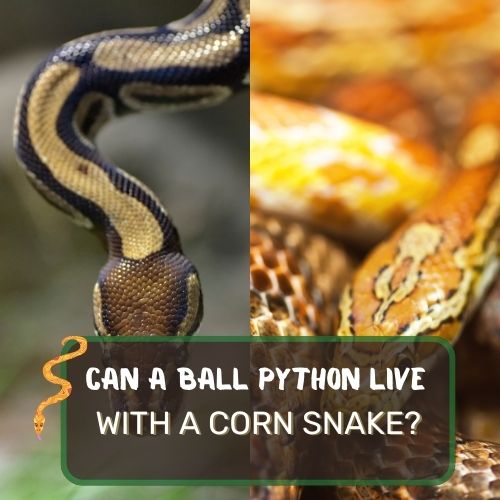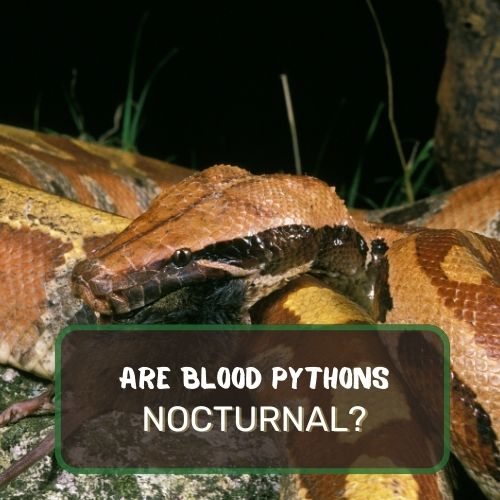
At first glance, the idea of these two popular pet snakes sharing a space might seem appealing. But, as with many things in the world of herpetology, the answer isn’t straightforward.
In this article, we delve deep into the unique characteristics, needs, and behaviors of both ball pythons and corn snakes.
We’ll explore factors like habitat requirements, temperament, health concerns, and more.
By the end, you’ll have a comprehensive understanding of the challenges and considerations of cohabitating these two species, ensuring you make informed decisions for your slithering companions.
Dive in and discover the fascinating world of these remarkable reptiles!
Table of Contents
Can a Ball Python Live With a Corn Snake?
While both ball pythons and corn snakes are popular pets and generally have docile temperaments, cohabitating them isn’t recommended. They have different habitat needs, behaviors, and potential health risks. Mixing species can lead to stress, aggression, or even the spread of diseases. Additionally, their environmental requirements, such as temperature and humidity, can vary. It’s essential to prioritize the well-being of each snake.
For the best care, it’s advised to keep them in separate enclosures tailored to their specific needs. Always consult with a herpetologist or reptile expert before making housing decisions.

Understanding Ball Pythons
Ball pythons, often celebrated for their docile nature, have become a favorite among reptile enthusiasts. But what makes them so special, and can they really coexist with corn snakes? Let’s dive deep into the world of ball pythons.
Origin and Natural Habitat
Native to the grasslands of West and Central Africa, ball pythons thrive in warm, tropical climates. They’re often found in grassy fields, abandoned mammal burrows, or even termite mounds.
The name “ball python” stems from their tendency to curl into a tight ball when threatened, a behavior rarely seen in other snake species.
In their natural habitat, these snakes experience a wet season, which is ideal for hunting, and a dry season, during which they often take refuge in burrows to stay hydrated and cool.
This cyclical environment has shaped their behavior and dietary habits.
Behavior and Temperament
Ball pythons are often lauded for their calm demeanor. Unlike some other snake species, they’re less likely to strike or show aggression, making them a top choice for beginners in the reptile-keeping world.
Their predictable behavior, combined with their manageable size, has contributed to their popularity.
However, it’s essential to note that while they’re generally docile, each snake is an individual. Some might be more curious and active, while others prefer to stay hidden and are more reserved.
Regular, gentle handling from a young age can help in ensuring they remain calm and accustomed to human interaction.
Size and Appearance
When it comes to size, ball pythons are relatively modest. Adult ball pythons typically range from 3 to 5 feet in length, with females generally being larger than males.
Their compact size is another reason they’re favored by many snake enthusiasts, especially those with limited space.
Appearance-wise, ball pythons are a visual delight. Their base color is usually a rich brown or black, adorned with lighter brown or gold patterns.
These patterns can vary significantly, leading to various morphs in the pet trade, each with its unique coloration and pattern.
From the classic wild-type appearance to intricate designer morphs, there’s a ball python look to captivate almost anyone.

Getting to Know Corn Snakes
Corn snakes, with their vibrant colors and easy-going nature, have carved a niche for themselves in the hearts of reptile aficionados. But what’s the story behind these captivating creatures, and how do they compare to ball pythons?
Where They Come From and Their Preferred Environment
Corn snakes hail from the southeastern United States, spanning areas from New Jersey to Florida and as far west as Tennessee. They’re commonly found in overgrown fields, forest openings, and even abandoned buildings.
The name “corn snake” is believed to have originated from their frequent presence in cornfields or possibly the maize-like pattern on their bellies.
In the wild, corn snakes experience a temperate climate with distinct seasons. They’re adept at regulating their body temperature, often basking in the sun during cooler days and seeking shade during the hotter periods.
This adaptability to varying temperatures is one reason they’ve become such a staple in the pet trade.
Their Friendly Nature and Why They’re Popular Pets
Corn snakes are often described as the “gentle souls” of the snake world. Their docile temperament, combined with their striking appearance, makes them a favorite, especially among first-time snake owners.
They’re curious creatures, often exploring their surroundings with keen interest, but without the aggressive tendencies some other snakes might exhibit.
Their ease of care, coupled with their forgiving nature (they’re less prone to stress compared to some other species), has skyrocketed their popularity in the reptile community.
They’re also known to be hardy, often thriving in captivity with the right care.
Physical Characteristics
Corn snakes are a visual spectacle. They typically sport a vibrant orange or reddish-brown base color, adorned with large, black-edged red blotches. Their bellies resemble a checkerboard pattern, often in black and white.
Adult corn snakes usually measure between 2.5 to 5 feet, making them comparable in size to ball pythons.
Their slender build, combined with their vivid coloration, makes them stand out. Over the years, breeders have also introduced various morphs, each with its unique color palette and pattern, further adding to their allure.
In the grand debate of “can a ball python live with a corn snake?”, understanding the corn snake’s background, behavior, and needs is just as vital.
As we’ll delve into next, while both snakes have their merits, their coexistence in a shared space presents challenges.

Factors to Consider Before Cohabitation
The idea of housing two beautiful snakes together might seem appealing, but it’s not as straightforward as it sounds. Cohabitation requires meticulous planning, observation, and understanding of each snake’s needs.
Let’s delve into the factors one must consider before even thinking about letting a ball python share a space with a corn snake.
Size of the Enclosure
First and foremost, space is paramount. Both ball pythons and corn snakes need room to move, explore, and have their own territories. A cramped space can lead to stress, territorial disputes, and health issues.
If you’re even contemplating cohabitation, you’d need an enclosure significantly larger than what you’d use for a single snake.
Monitoring Both Snakes’ Health
Health checks become doubly important. Diseases can spread rapidly in shared spaces. Regular vet check-ups, coupled with daily observations for signs of distress, unusual behavior, or physical ailments, are crucial.
Remember, a healthy snake is an active, curious snake. Any deviation from their usual behavior warrants attention.
Ensuring Separate Hiding Spots
Snakes, by nature, are solitary creatures. They value their privacy and often seek refuge in hiding spots, especially after a meal or during shedding.
Ensure multiple hiding spots are available in the enclosure, allowing each snake its sanctuary. This reduces stress and potential confrontations.
Observing Their Behavior When Introduced
Before permanent cohabitation, it’s wise to introduce the snakes in a controlled environment and observe their behavior. Look for signs of aggression, like hissing, striking, or dominant posturing.
If either snake seems overly stressed or aggressive, it’s a clear sign that cohabitation might not be a good idea.
Feeding Precautions
Feeding time can be a potential flashpoint. Snakes can become particularly aggressive when food is involved. It’s recommended to feed the snakes separately to avoid any confrontations.
There’s also the risk of one snake mistakenly biting the other during feeding, mistaking it for food.
Monitoring Temperature and Humidity for Both Species
While both ball pythons and corn snakes thrive in controlled environments, their specific temperature and humidity needs can vary. Ball pythons, being tropical creatures, might prefer higher humidity levels compared to corn snakes.
Regularly monitoring and adjusting the temperature and humidity to cater to both species’ needs is essential for their well-being.

Potential Risks and How to Mitigate Them
The idea of cohabitating two distinct snake species, like the ball python and corn snake, is rife with potential pitfalls.
While the allure of a shared space might seem economical and visually appealing, the welfare of the snakes should always be paramount. Let’s delve into the potential risks and ways to mitigate them.
Stress and its Signs in Snakes
Stress in snakes can manifest in various ways. They might become more reclusive, refusing to eat, or exhibit erratic behavior. Rapid breathing, frequent hiding, or even aggressive posturing can be clear indicators.
It’s essential to recognize these signs early, as prolonged stress can lead to severe health issues.
Mitigation: Regularly monitor your snakes and ensure their environment is tailored to their needs. Any sudden changes in behavior should be addressed promptly, possibly with the help of a herpetologist or vet.
The Risk of One Snake Preying on the Other
While ball pythons and corn snakes aren’t natural predators of each other, in a confined space, the larger snake might mistake the smaller one for prey, especially during feeding times.
Mitigation: Always feed the snakes separately. Regularly monitor their interactions, especially during their active periods, to ensure no aggressive behavior is developing.
Ensuring a Stress-Free Environment
A stress-free environment is crucial for the well-being of both snakes. This means an adequately sized enclosure, multiple hiding spots, and a habitat tailored to their needs.
Mitigation: Invest in a spacious terrarium, provide ample hiding spots, and ensure the temperature and humidity levels cater to both species. Regularly clean the enclosure to prevent the buildup of waste.
Differences in Habitat Requirements
While both snakes hail from warm environments, their specific habitat needs can vary. Ball pythons, for instance, might prefer higher humidity levels compared to corn snakes.
Mitigation: Invest in quality thermometers and hygrometers. Regularly monitor and adjust the environment to ensure it’s optimal for both species.
This might mean creating zones within the enclosure that cater to each snake’s specific needs.
Risks of Disease Transmission
Different species can carry different pathogens. In a shared space, there’s an increased risk of disease transmission, which can be detrimental to the snakes’ health.
Mitigation: Regular vet check-ups are crucial. Any sign of illness, like lethargy, refusal to eat, or skin issues, should be addressed immediately.
Quarantine new snakes before introducing them to the shared space to ensure they’re disease-free.
The Territorial Nature of Snakes
Snakes, by nature, are solitary creatures. In a confined space, territorial disputes can arise, leading to stress or even physical confrontations.
Mitigation: Ensure the enclosure is spacious enough for both snakes to have their territories. Multiple hiding spots, basking areas, and climbing structures can help in reducing territorial disputes.
The idea of cohabitating a ball python and corn snake might seem tempting but it’s fraught with challenges. Each risk, if not addressed promptly, can lead to severe consequences for the snakes.
As caretakers, it’s our responsibility to ensure our pets’ well-being, even if it means keeping them in separate spaces.

Alternatives to Cohabitation
While the idea of housing two snakes together might seem appealing, sometimes it’s just not in the best interest of the animals.
But fear not! There are alternatives that ensure both snakes get the care they need without the risks associated with cohabitation.
Separate Enclosures Side by Side
One of the most straightforward solutions is to have two separate enclosures placed side by side. This allows both snakes to have their space tailored to their needs while still being in close proximity.
It’s a win-win!
Using a Partition in a Large Enclosure
If space is a concern, consider getting a large enclosure and using a partition to divide it. This ensures both snakes have ample space, but without the risks associated with direct interaction.
Just ensure that the partition is secure and that each side caters to the specific needs of the resident snake.
Rotational Handling to Give Each Snake Attention
Both ball pythons and corn snakes benefit from regular handling. By having separate enclosures, you can ensure each snake gets its share of attention and interaction, strengthening your bond with each of them.

Final Word
You’ve journeyed through the intricate world of ball pythons and corn snakes, unraveling the complexities of their cohabitation.
As you’ve discovered, while both species are captivating in their own right, their coexistence in a shared space presents challenges.
From understanding their unique habitat needs to recognizing the signs of stress, it’s clear that the well-being of these snakes should always be the top priority. But remember, with knowledge comes empowerment.
Now that you’re equipped with this information, you’re in a better position to make informed decisions for your reptilian companions.
Whether you choose to house them separately or find innovative solutions, always prioritize their health and happiness.
Keep learning, stay curious, and remember: every step you take in understanding these magnificent creatures ensures a brighter future for them.
Here’s to many joyful moments with your slithering friends!
More Questions That You May Have
Do corn snakes get along with ball pythons?
While both species are generally docile, their interactions can be unpredictable. It’s always best to monitor any interactions closely and prioritize their individual needs.
Do ball pythons get along with other snakes?
Ball pythons, like most snakes, are solitary by nature. While they might tolerate other snakes, cohabitation always comes with risks and should be approached with caution.
Is it better to get a corn snake or ball python?
Both snakes have their merits. Corn snakes are hardy and easy to care for, making them great for beginners. Ball pythons, with their calm demeanor, are also a popular choice. It boils down to personal preference and the kind of experience you’re looking for in a pet snake.




0 Comments